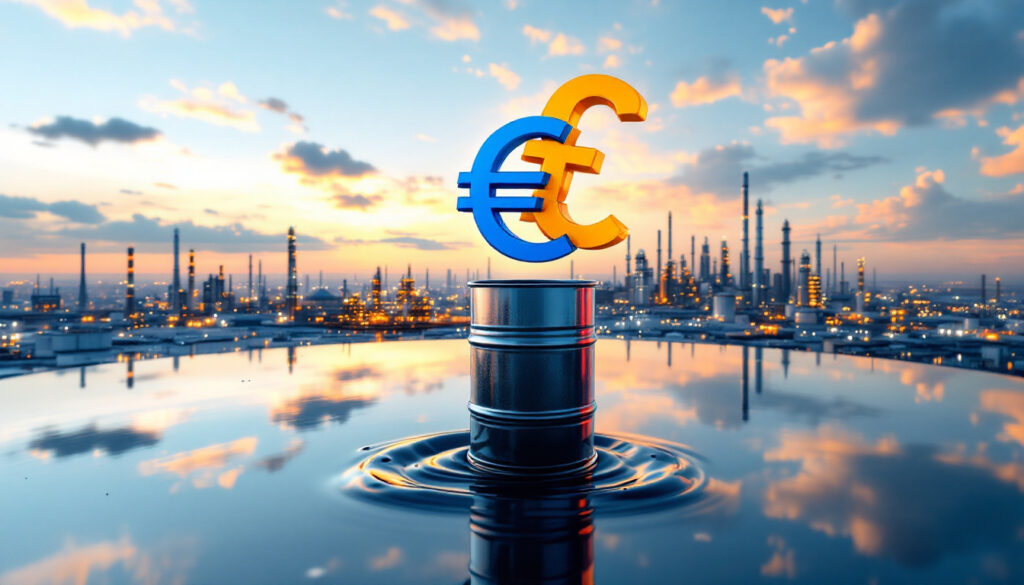Understanding Oil Prices in Euros: A Comprehensive Analysis
In global energy markets, oil is predominantly traded in US dollars, but for European consumers and businesses, the price in euros is what truly matters. The unique interplay between currency markets and oil prices creates a distinctive dynamic that affects European economies, businesses, and consumers in ways that differ from their American counterparts. Furthermore, understanding global commodity insights becomes essential for investors seeking to navigate this complex landscape. This analysis examines the current state, historical context, and future outlook of oil prices when viewed through the euro lens.
How Have Oil Prices in Euros Performed in 2025?
Current Price Levels and Year-to-Date Performance
Brent crude priced in euros currently stands at approximately €58 per barrel, representing a substantial 19% decline year-to-date in euro terms. This price level marks a significant milestone for European oil consumers, as it hovers near the lowest levels observed since 2021. What makes this decline particularly noteworthy is the divergence between euro-denominated and dollar-denominated oil prices. While European buyers have experienced a 19% reduction, Brent futures are down only 11% in dollar terms for the same period – creating an 8 percentage point gap in performance.
As Alex Longley of Bloomberg notes, "Dollar weakness has amplified the oil price decline for European buyers, creating arbitrage opportunities that weren't available just months ago." This divergence highlights how currency movements can significantly impact commodities when viewed from different monetary perspectives.
The Dollar-Euro Exchange Rate Impact
The weakness of the US dollar against the euro in 2025 has played a crucial role in amplifying oil prices in euros for European buyers. Currency exchange dynamics have essentially provided European consumers with an additional discount on oil purchases beyond what global oil market fundamentals would suggest.
This divergence between dollar-denominated and euro-denominated oil prices creates a unique situation where identical barrels of oil are effectively 8 percentage points cheaper for European buyers than the headline global price movements would indicate. Such currency-driven price advantages can have far-reaching implications across European industrial sectors, transportation networks, and consumer energy costs.
Why Are Oil Prices Different in Euros vs. Dollars?
Currency Exchange Dynamics
Oil is traditionally priced in US dollars in global markets, which means that any fluctuation in the EUR/USD exchange rate directly impacts the effective price European buyers pay. When the euro strengthens against the dollar, as it has during portions of 2025, European buyers can purchase the same amount of oil for fewer euros.
The mechanics behind this process involve straightforward currency conversion. For example, if Brent crude trades at $65 per barrel and the EUR/USD exchange rate is 1.12 (meaning €1 buys $1.12), the euro price would be approximately €58 per barrel ($65 ÷ 1.12). If the euro strengthens to 1.20, that same barrel would cost only €54.17 – a significant saving created purely through currency movements rather than any change in the underlying oil price.
Bloomberg Markets analysts have observed that "the divergence between dollar and euro oil prices has created a competitive advantage for European industrial consumers that American counterparts don't enjoy."
Purchasing Power Implications
European industrial consumers benefit substantially from lower effective oil costs in the current environment. Manufacturing sectors that rely heavily on petroleum products as inputs or energy sources can experience improved cost structures compared to global competitors operating in dollar-based economies.
European refineries, in particular, may experience improved margins compared to US counterparts when oil prices decline more significantly in euro terms. As noted in a recent ECB report, "Lower oil prices ease pressure on manufacturing and transportation sectors," providing breathing room for industries facing other competitive challenges.
Additionally, import costs for oil-dependent European economies are reduced despite global oil market volatility. For countries like Italy, Spain, and Germany, which import substantial volumes of crude oil, the 8 percentage point advantage created by currency movements translates to billions in savings on national energy bills.
What Are the Historical Patterns of Oil Prices in Euros?
Key Historical Benchmarks
The current €58 per barrel level represents a significant decline from recent years, with comparable price levels last seen in 2021 when post-pandemic economic recovery was still gathering momentum. During that period, prices ranged in the €55–€60 per barrel band as global demand remained subdued.
Historical analysis reveals that currency fluctuations have frequently affected European oil costs in ways that diverge from headline dollar prices. During the 2008 financial crisis, for example, the dramatic collapse in oil prices was partially offset for European buyers by dollar strength, limiting the benefits of the global price crash. Conversely, during the 2014-2016 oil price decline, euro weakness against the dollar meant European consumers didn't fully realize the benefits of cheaper global oil prices.
BloombergNEF research indicates that "currency fluctuations amplified price swings during the 2008 financial crisis," creating additional volatility for European energy consumers beyond what oil market fundamentals alone would have produced.
Comparison with Previous Market Cycles
The current situation bears some resemblance to previous periods of dollar weakness, particularly during 2017-2018 when the euro strengthened significantly against the dollar while oil prices were rising. During that period, European buyers were partially insulated from global oil price increases by favorable currency movements.
What makes the current cycle unique is the combination of falling oil prices and a strengthening euro, creating a "double discount" effect for European buyers. This combination hasn't been seen at this magnitude since the early 2010s, making the current environment particularly favorable for European energy consumers. Understanding these commodity cycle shifts is crucial for investors looking to capitalize on emerging opportunities.
What Does This Mean for European Economies?
Economic Advantages for Euro-Based Oil Consumers
The manufacturing sector across the Eurozone stands to benefit significantly from lower euro-denominated oil prices. Energy-intensive industries such as chemicals, steel, glass, and cement production experience direct cost benefits through reduced input costs. According to Eurostat data, energy costs typically represent between 5-20% of total production costs in these sectors, making the current price environment particularly advantageous.
Transportation and logistics companies also realize substantial cost reductions when fuel prices fall. With diesel prices closely linked to crude oil, the trucking industry, shipping companies, and airlines operating in euros see immediate benefits to their bottom lines. A survey of European logistics firms indicated that the 19% reduction in euro-denominated oil prices has translated to approximately 7-9% reductions in overall operating costs.
Perhaps most significantly for European economies broadly, the Eurozone inflation rate has been reduced by approximately 0.5% due to lower energy costs, according to ECB estimates. This moderation in inflation provides central bankers with additional flexibility regarding monetary policy decisions.
Energy Security Considerations
Lower euro-denominated oil prices affect European energy policy decisions in complex ways. While economic benefits are immediate, there's concern among policy analysts that sustained low prices could undermine investment in renewable energy alternatives if fossil fuels remain too economically attractive by comparison.
The IEA has noted that renewable energy investment competitiveness can be challenged when oil prices fall below certain thresholds. Projects with marginal returns based on higher expected fossil fuel prices may face more difficult financing conditions when oil prices decline significantly.
For strategic petroleum reserve management, the current price environment presents an opportunity for European nations to replenish or expand reserves at favorable prices. Several EU member states have initiated programs to increase their strategic petroleum reserves while prices remain attractive, taking advantage of the strategic role of cash in their investment portfolios.
How Do Oil Traders Navigate Currency Fluctuations?
Hedging Strategies for Currency Risk
Approximately 60% of EU oil importers hedge currency risk via futures contracts, according to industry surveys. Common approaches to managing currency exposure in oil trading include forward contracts, futures, options, and swaps designed specifically to lock in favorable exchange rates independently from commodity price movements.
The TotalEnergies CFO recently noted, "We use forex swaps to lock in EUR/USD rates for quarterly contracts," highlighting the sophisticated risk management strategies employed by major European energy companies.
Financial instruments commonly used to hedge euro-dollar exchange rate risks include:
- Currency futures contracts that establish a predetermined exchange rate for a future date
- Options contracts that provide the right, but not obligation, to exchange currencies at specified rates
- Cross-currency swaps that allow companies to exchange interest and principal payments in different currencies
Major European oil companies typically employ dedicated treasury teams focused specifically on managing currency risks independently from commodity price risks, treating each as a separate exposure requiring specialized management strategies.
Trading Opportunities in Currency-Adjusted Oil Markets
Arbitrage possibilities emerge between different currency-denominated oil contracts when divergences become substantial. Sophisticated traders with access to multiple markets can capitalize on pricing inefficiencies created by currency movements, though these opportunities typically close quickly as markets adjust.
Traders can capitalize on divergences between dollar and euro oil price movements through various strategies. One approach involves simultaneously taking positions in dollar-denominated oil futures while hedging currency exposure through euro/dollar forex positions. Another strategy leverages differences between physically delivered oil contracts in different regions where currency effects create pricing discrepancies.
The current 8 percentage point gap between dollar and euro performance has created unusually persistent arbitrage opportunities throughout 2025, attracting increased trading activity from financial institutions specializing in cross-market strategies. Investors implementing geopolitical investor strategies can find unique advantages in this environment.
FAQ About Oil Prices in Euros
What factors determine oil prices in euros?
Oil prices in euros are determined by a combination of global oil supply and demand fundamentals and currency exchange dynamics. On the fundamental side, OPEC+ production decisions, global inventory levels, demand growth in major economies, and geopolitical disruptions all affect the baseline dollar price of oil.
These dollar-denominated prices are then filtered through the EUR/USD exchange rate, which is influenced by relative economic strength, interest rate differentials, trade balances, and capital flows between the Eurozone and United States. The resulting euro price reflects both oil market conditions and the relative strength of the two currencies.
European-specific demand factors can also influence local pricing through refinery utilization rates and product crack spreads, creating regional premiums or discounts to global benchmarks. Geopolitical events affecting energy markets, such as conflicts in major production regions or sanctions policies, contribute a risk premium estimated at 5-7% of 2025 oil prices according to IEA analysis. Additionally, Trump's energy policies could significantly impact future market dynamics.
How do central bank policies affect euro-denominated oil prices?
ECB monetary policy has a direct impact on the euro through interest rate decisions and quantitative easing programs. When the ECB maintains higher rates relative to the Federal Reserve, the euro typically strengthens, reducing euro-denominated oil prices all else being equal.
Federal Reserve decisions affecting the dollar work in the opposite direction – tightening Fed policy strengthens the dollar and potentially increases euro-denominated oil prices even if the underlying commodity price remains stable. Goldman Sachs analysts have noted that "ECB rate cuts in 2025 could weaken the euro further," potentially offsetting some of the benefits European consumers have enjoyed from currency movements.
Interest rate differentials between the US and Eurozone are particularly important for currency valuations, as capital tends to flow toward higher-yielding currencies, all else being equal. When the interest rate gap narrows or widens, currency valuations adjust accordingly, directly affecting oil prices in euros.
Are there advantages to purchasing oil in euros versus dollars?
For European entities, purchasing oil in euros removes currency risk from the equation, providing greater certainty for budgeting and financial planning. While global oil markets remain predominantly dollar-denominated, an increasing number of contracts, particularly between European buyers and non-US sellers, are being denominated in euros.
Strategic benefits for European entities include reduced exposure to US monetary policy decisions and sanctions regimes. As more oil-producing nations seek to diversify away from dollar dependence, opportunities for euro-denominated purchases have expanded, particularly with Russian and Middle Eastern suppliers seeking to reduce dollar exposure.
Long-term contract pricing in euros can provide stability for European buyers during periods of currency volatility, though it transfers the currency risk to sellers who may demand a premium for accepting this exposure.
What's the Outlook for Oil Prices in Euros?
Key Factors to Watch
Projected euro-dollar exchange rate trends will be crucial for determining future euro-denominated oil prices. The IMF forecasts the EUR/USD rate at approximately 1.15 by Q4 2025, which would maintain the currency advantage European buyers have recently enjoyed if realized.
Global oil supply and demand forecasts from major agencies suggest modest price pressures in coming quarters as OPEC+ production discipline faces off against concerns about Chinese demand growth and accelerating US shale production. Wood Mackenzie analysts note that "structural shale supply growth may cap long-term dollar-denominated prices," potentially creating a favorable environment for European consumers if currency strength persists.
Geopolitical risks that could affect either oil markets or currency valuations remain ever-present. Tensions in the Middle East, particularly regarding Iran's nuclear program and ongoing conflicts in several production regions, could create supply disruptions that overwhelm currency advantages. Simultaneously, diverging monetary policies between the Federal Reserve and ECB pose risks to currency stability.
Expert Predictions
Analyst forecasts for euro-denominated oil prices reflect cautious optimism for European energy consumers. The consensus view suggests prices remaining in the €55-65 range through year-end, assuming no major geopolitical disruptions or dramatic shifts in monetary policy.
Potential scenarios for European energy costs include a "soft landing" case where moderate global growth maintains oil demand while currency stability preserves European advantages. Alternative scenarios include a "stagflation risk" where slower growth coincides with persistent inflation, complicating central bank responses and potentially weakening the euro.
Long-term structural factors affecting the relationship between oil and currency markets suggest the potential for increased volatility as traditional correlations break down. The energy transition, changing trade relationships, and shifts in global reserve currency usage all contribute to an increasingly complex environment for forecasting euro-denominated energy costs beyond the immediate horizon.
Want to Catch the Next Major Mineral Discovery?
Discovery Alert's proprietary Discovery IQ model instantly notifies investors about significant ASX mineral discoveries, transforming complex geological data into actionable trading opportunities. Explore why historic discoveries can generate substantial returns by visiting Discovery Alert's dedicated discoveries page and begin your 30-day free trial today to position yourself ahead of the market.




